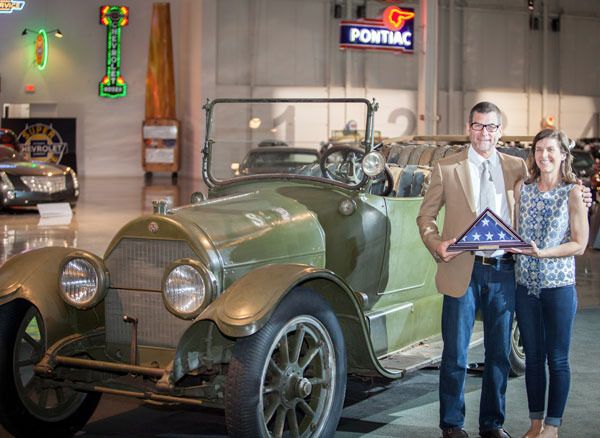There are automotive enthusiasts — and then there are collectors like Marc Lassen of Gardiner, who are zealous in the pursuit of their vehicles’ histories. To call the 47-year-old passionate in his lifelong appreciation of cars is an understatement — he’s been buying, fixing and trading them since he was 15.
“My father had a 1926 Buick and I used to play in it — it was my happy spot, with a mohair interior and the scent of mohair and mothballs, so I’ve had a lifelong love of old cars,” Lassen said.
Chalk it up to serendipity or kismet — in a 2005 online search for a taillight for his 1929 Cadillac, he stumbled upon an ad for a 1918 Cadillac Type 57 V-8 touring car, with these tantalizing words: “army green, may have belonged to some general.” Immediately he contacted the Florida owner and headed up to where it was stored in Spokane. He said a fair deal was struck and he trailered it back home. Although the car had been shedded for a decade in Spokane, it had seen a hard life with a dented fender, holes in the running boards, cracked and missing leather on its front and back seats and what appeared to be a bullet hole, but surprisingly spared from corrosion. Even the V-8 engine turned freely with good compression.
That was nine years ago and what a roller coaster ride he was in for in uncovering the car’s supposed military provenance.
“I was told by one military expert that none of these World War I Cadillacs survive and without the proven military history, ‘I just had a neat green car and I’d never be able to to prove it.’”
Working backwards from the present, he first contacted Cadillac’s archives with the VIN number, learning it was delivered to a dealer in New York City on July 31, 1917, 97 years ago. It was delivered to a J.M. Dennison on Aug. 9, 1917, as a dark blue touring car with 34-inch by 4-inch tires and a retractable soft top. The trail ended almost as soon as it had begun — there were no records of J.H. Dennison in New York. Lassen asked for a larger copy of the Cadillac’s factory build document written in cursive and was elated to realize the “M” was an “H,” leading him to the original owner, Dr. John Hopkins Dennison, who was affiliated with Williams College in Williamstown, Mass. From Dennison’s 1926 book, Lassen found a trove of information about Dennison’s time in World War I as an officer’s chauffeur for the American Expeditionary Forces in that very Cadillac and with a photo of him in the car to prove it.
A chance layover in Minneapolis this year and a day sleuthing on the American Expeditionary Forces Leave system at the Kautz Archive at the University of Minnesota “was my most productive day in my nine years of research,” Lassen said. He found photos of Dennison posed in the car in France with and without its ordinance markings. He also discovered that Dennison had chauffeured President Theodore Roosevelt’s daughter-in-law Eleanor around for two months in the Cadillac on a tour of southern and central France.
“Things kept breaking in our favor,” Lassen said. “It’s lucky that it survived and came back to the U.S.,” he said, noting that more than 99 percent of U.S. military vehicles were scrapped in France after the war.
“It was in service for another 20-plus years and was preserved for almost 80 years without anybody messing with it. It’s a perfect time capsule. I’m a preservationist not a restorationist, so this fall the car will undergo light mechanical preservation to get it running and driving again.”
To do other do any more, Lassen said, would be akin to repairing the crack in the Liberty Bell.
From the U.S. to France and back, the Cadillac also spent time in California, Oregon, Montana and Washington. Although Lassen hasn’t found a general in its history as the ad implied, the car did belong to a Major M.C. Bradley from Los Angeles and it stayed in his collection from 1925-1968.
On July 22, the Cadillac was recognized at General Motors headquarters near Detroit as a National Automotive Heritage Monument by the Historic Vehicle Association. From July 25-27, Lassen exhibited the car at the Concours d’Elegance of America in Plymouth, Mich., “the most prestigious showing of (300) classic, rare and important autos in the world.”
Next year when it’s running, Lassen said, “I don’t plan on driving it in Sequim because it’s too important to just tool around in — it’s safer for the car. Its provenance made it a very special car in automotive and military history.”
Lassen has dubbed vehicle the “Liberty Cadillac” an noted that several museums are interested in putting it on exhibit.
“I feel fortunate to find this car and it’s an honor for me to reunite the car with its great military provenance. It’s been a wonderful odyssey of nine years of research,” Lassen said.
“It’s American history and it’s pretty cool. My goal all along has been that it should be shared and celebrated. The best part has been researching and sleuthing for the details and finding pieces of the puzzle. It’s been a thrill to have accomplished what I have accomplished. This has been the experience of a lifetime and it’s been very exciting and rewarding.”
For another article on the Liberty Cadillac, see the link to the New York Times below and/or watch Lassen’s video on YouTube, also listed below.
Links to Marc Lassen’s 1918 Cadillac project
• www.youtube.com/watch?v=6BBCqNlKJ-Y



